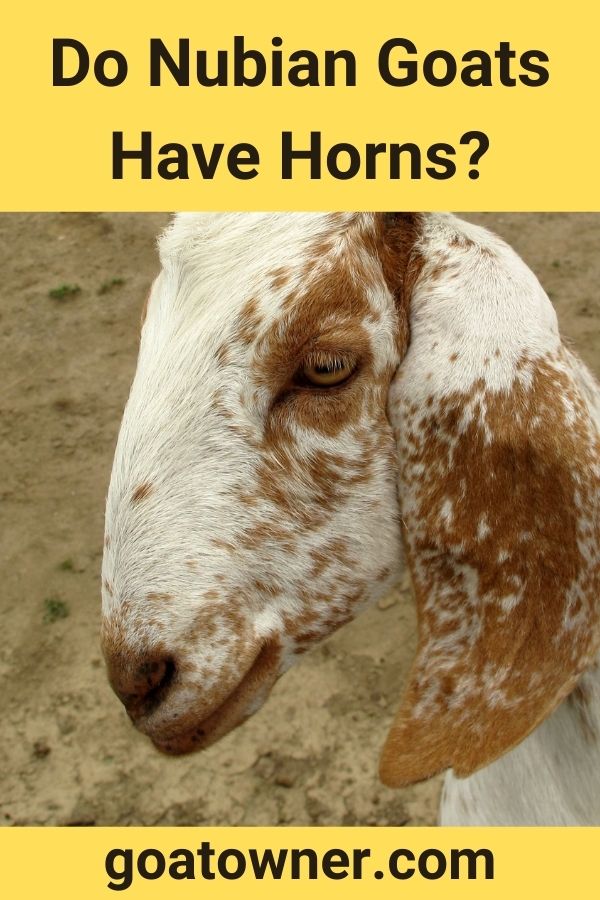I was out a livestock auction the other day with my son, when one lot of Nubian goats was brought in for sale.
They were a group of females and one male, and they were fine-looking goats.
However, something my son immediately noted was that none of them had horns.
If one of them was a male, surely one of them should have had horns.
He made a good point, and I’m ashamed to say I didn’t have a good answer for him—I’ve only ever been a goat hobbyist!
When I got home, I decided to look into it.
So, do Nubian goats have horns?
Yes, male Nubian goats have horns naturally. They are very often polled by farmers, meaning their horns are removed at an early age. Their horns grow backward along the neck, curving at the end. They usually start to come in around 3 weeks old.
So, what we saw was a male Nubian whose horns had been deliberately stopped from growing by their owner.
This is done simply to make the animal more manageable, and less likely to injure its carers!
Let’s look further into this.
Are Nubian goats naturally polled?
No, they’re not.
Nubian goats naturally have horns—at least the males do.
The process of removing a goat’s horns is an artificial process invented by humans.
A goat being polled simply means it has no horns, and while this can happen naturally, it’s exceedingly rare.
Nubian goats are not naturally polled.
Nubians do indeed have horns, and they will generally come in quite early in their lives.
By the time they’re about 3 weeks old, they will be showing signs of horns.
In the first year of growth, Nubian’s horns will grow by as much as 10 inches.
Related Post: How Long Do Nubian Goats Live? (Answered!)
They may continue to grow after that, but the growth will slow down enormously.
In any case, Nubian goats are not naturally polled—99% of the time.
As I said, it does happen.
Most of the time, though, it is through a deliberate intervention that horns are prevented from growing.
They are not removed at a later date.
This would be immensely painful to the goat.
Rather, the horns are curbed at an early age.
Why, then, are Nubian goats artificially polled—or disbudded—by humans?
Why are Nubian goats polled?
Usually, there’s a fairly simple reason.
Whether you’re keeping goats for meat, milk, or companionship, having more than one male around isn’t always easy—they can very often get possessive and territorial.
Even if you have only one, they are still a bit of a handful—especially a full-sized bull Nubian.
Headbutting is a common problem, and, as I’m sure you can guess, being headbutted by a disbudded goat is much better than being hit full force with the horns!
So, that’s all it really comes down to.
It’s about making the goat easier to handle when it becomes a boisterous and grumpy old man.
What about the females?
Do female Nubians have horns?
There’s a simple answer to this one, too.
Female goats do not have horns.
This is true more or less of all types of goats.
There are some species, such as mountain goats, that do occasionally show females with horns.
But this is more or less the only example.
Horns serve one real purpose: competing with other males.
Whether it’s for the attention of a female, for food, or anything they need, males will butt heads with other males in order to get what they want.
Females live in herds and are more than happy living together in large numbers.
They don’t need to compete for the attention of males, but let them compete amongst themselves.
Therefore, they’ve no need for horns.
Again, this is true of Nubians, and pretty much any other breed you could imagine.
What breeds of goat don’t have horns?
There are actually no naturally polled breeds of goat.
You can find many examples of polled cows and sheep, but there are no such examples in the goat world.
They all have horns, whether because cows and sheep have been bred a deal more or any other reason.
The fact is naturally polled goats really don’t exist.
However, the idea of disbudding is certainly becoming less and less attractive in the modern world of goat breeding.
Fewer and fewer breeders relish the idea of removing each goat’s horns naturally.
With that in mind, renewed efforts to breed a naturally polled breed of goat are starting up again.
All breeds of cattle and sheep would, before we got involved, have had horns of some description.
Now, as you can see, there are many breeds that completely lack horns.
So, a goat breed that is naturally polled is certainly entirely achievable, it’s just going to take some more years of breeding and experimenting.
Whether it will be the descendent of Nubian goats, though, is another question.
They are certainly preferred for the ease of disbudding, so it could make them a viable candidate.
Nubian goats have horns just like any other breed, then.
Polling is a common practice and is a simple way of making a goat more manageable.
Being naturally polled isn’t unheard of, but it’s very rare, and it is not a definite feature of any one breed.
All male goats naturally have horns.
The only time an adult male goat will not have horns is in the rare case that they were naturally polled, or in the case that they were polled by their owner.

